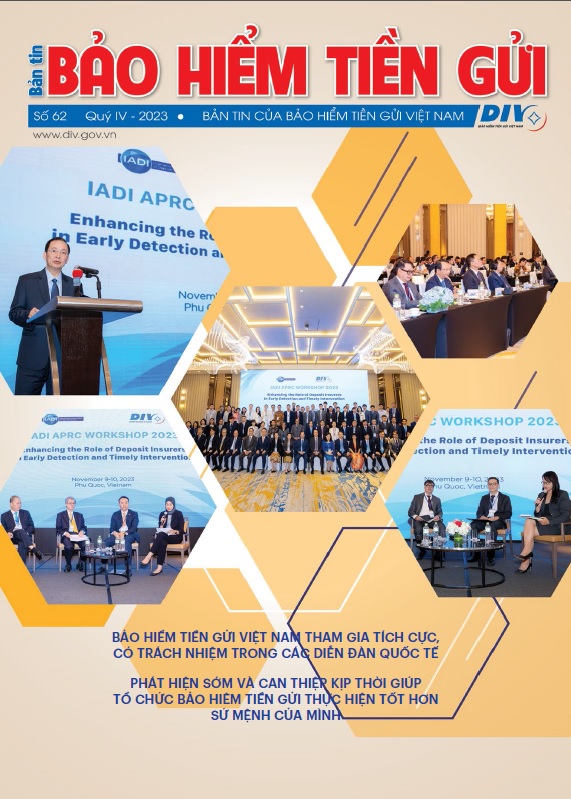PCFs are credit institutions (CIs) voluntarily established by legal entities, individuals and households in the form of cooperatives to carry out a number of CI activities in accordance with the provisions of the Law on CIs and the Law on Cooperatives with the main purpose of mutual assistance to improve the production, business and living standard. PCFs are typically small-scale businesses that are located in small, constrained and unevenly-allocatedareas,have limited risk tolerance, and may be easily affected by market fluctuations. So far, the PCF system includes 1,181 PCFs spreading throughout 57 provinces and cities across the country.
The analysis of PCFs’ financial position is the process of examining, reconciling and comparing the data and documents about the current and historic financial situation to assess potential risks and business performance in the future. It should be noted that the main source of operational capital of PCFs is mobilized capital, the owner’s equity accounts for a modest proportion but plays a vital role in assuring their safety. Therefore, while analyzing the financial situation of PCFs, it is necessary to pay attention to the use of equity ratio for comparison and assessment. Besides, the supervision results of PCFs in recent years suggest that a substantial fraction of the PCFs placed under special control (SC) have operational risks, thus the analysis of PCFs should focus on detecting risks of PCFs’ operations.
The financial analysis serves a variety of purposes for different information users, specifically:
For managers and executives of PCFs, the financial analysis helps them understand the current status of the PCF and develop an effective business plan for the future.
For regulatory agencies and the Deposit Insurance of Vietnam (DIV), the analysis of PCFs’ financial position assists them in assessing the potential risks in PCFs’ operations, making recommendations and suggestions to adjust the operations of PCFs to a safer manner, safeguarding depositors’ interests. For the State Bank of Vietnam (SBV), the financial analysis of PCFs in particular, and the whole CI system in general, is a basis for assessing systemic risks and helping the SBV to research and introduce changes in the legal corridor for the stabilize development of the CI system, avoiding risks and negative impacts on the national finance.
According to the guidance of the International Association of Deposit Insurers (IADI), some available methods for early detection and timely intervention include:
Firstly, the Early Warning Systems are usually based on using various statistical models to estimate the likelihood of failure or the severity of financial distress over a fixed time horizon, or to predict future insolvency by estimating potential failure losses. Statistical models are typically intended to identify risks that can cause adverse future conditions in a bank. The objective of these systems is to identify potential risks in problem banks in a sufficiently timely manner, such that action can be taken by the appropriate authorities to minimize the losses or likelihood of losses arising from those risks. The inabilities to capture qualitative factors (e.g. quality of management, internal controls, risk management practices), and to consider the effects of competitive and environmental factors, are the main disadvantages in these models.
Secondly, the supervision rating systems such as CAMELS, CAEL (United States, etc.),PATROL (Italy) and ORAP (France) can be based both on the results of on-site examinations (on-site examination ratings) and on off-site analysis of regulatory and other available information including on-site examination reports (off-site supervisory ratings). Supervisory rating systems provide a structured and comprehensive framework. Quantitative and qualitative information is collected and analyzed on a consistent basis; the analysis is focused on deviations from “normal”.
Thirdly, comprehensive bank risk assessment systems, in which a bank or banking group is disaggregated into significant business units and each unit is assessed for all business risks. Scores are assigned for each assessment criterion, and are then aggregated to the next higher level to ultimately arrive at a final assessment or score for the bank or banking group.
Fourthly, indicators of possible weaknesses.
For problem bank identification, it may be useful to complement micro-level indicators with macro-level indicators. Macro-level indicators include aggregated microprudential indicators (AMPIs), market-based indicators (MBIs) and macroeconomic indicators (MEIs).The AMPI framework recommended by the IMF is based on the assessment of six groups of aggregated indicators: capital adequacy; asset quality; management soundness; earnings and profitability; liquidity; sensitivity to risk.
The aggregated indicators provide information relating to risk trends in groups of banks and the banking sector as a whole. The indicators are derived from individual banks’ balance sheets and other detailed financial information; they are then aggregated and used to identify systemic trends and individual banks’ weaknesses. In practice, most supervisors use similar indicators, although the details can vary. In addition, two main quantitative early detection methods are available, which it is advisable to use for assessing credit performance and default predictions: the Moody’s KMV model and the Z-scores model.
To analyze the PCFs’ financial postion, the DIV follows a process consisting of these main steps:
To begin, collecting and processing input data: The information received from the SBV in accordance with the provisions of the Circular No. 34/2016/TT-NHNN and other relevant documents is the primary data used by the DIV in the financial position analysis process. In addition, the DIV collects data on its own through other channels such as the PCFs, the DIV’s staff participating in the Special Control Board (SC Board) or the mass media, etc. To create a comprehensive and accurate source of information, the DIV compares, examines, reconciles, unifies and summaries the data collected.
Then, analyzing and assessing data: The analysis and evaluation of PCFs’ performance are based on the indicators on capital, asset quality, business performance result, liquidity. Then the PCFs are divided into groups, especially those placed under SC and problem ones. For the DIV, the monitoring indicator system applied to PCFs, micro-finance institutions (MFIs) and Cooperative Bank (CB), includes: overall performance analysis indicators of CB, PCFs and MFIs; surveillance indicator system built upon CAMEL model; indicator system assessing the compliance on prudential regulations in operation; indicator system according to the PEARLS model (applied to PCFs). The PEARLS model is a system designed to monitor the financial performance of depository institutions, especially small-scale financial institutions such as PCFs.
After that, on the basis of analyzing and assessing data, making periodic or ad-hoc reports when required.
Lastly, the DIV will deal with the results based on the PCFs’ financial position analysis: Coordinating, making recommendations and suggestions to the SBV, SBV branches in provinces and cities on the supervision, examination and resolution of problem PCFs, and cooperating with SBV branches in implementing the Regulation on provision of information.
It can be said that, thanks to the PCFs’ financial position analysis and assessment, the DIV has contributed to the state management of the PCFs by making timely recommendations, proposals to the SBV. However, in recent years, the number of PCFs placed under SC are increasing, therefore, for the DIV in particular and regulatory agencies in general, more efforts should be made in enhancing the efficiency of PCFs’ financial position analysis to promptly detect risks of PCFs, and take measures to avoid causing serious problems to PCFs, protect legitimate rights and interests of depositors, ensure the stability and safety of the CI systemand the national financial system.
In order to improve the efficiency of PCFs’ financial position analysis, the DIV should focus on these matters:
First, continue to exploit and exchange information with focal point agencies and units in order to collect information in a timely, accurate and comprehensive manner.
Second, the DIV must regularly update and research relevant domestic legal documents, as well as international financial indicators to adjust and develop their own set of indicators for analyzing and assessing financial situation of PCFs in particular and CIs in general. Promote the use of information technology, software in the calculation, statistics and analysis of PCFs’ financial position and the reporting regime as prescribed by law.
Third, develop a set of tools to measure and analyze the operational risk, which is a common risk for PCFs nowadays. The study of international experiences to complement the operational risk indicators of PCFs is a crucial requirement in the context of increasing number of PCFs placed under SC.
Fourth, the DIV can use additional predictive analytics tools to further improve the efficiency of the analysis process. Methods such as regression, linear programming and econometrics model will help forecast the indicators in financial statements, operational indicators of each PCF, as well as the PCF system, serving the risk-based supervision. This is a matter that also needs additional attention when researching international practices and experiences from countries with advanced deposit insurance model.
Fifth, continue to strengthen the training, coaching, information and experiences sharing on analyzing PCFs’ financial position within the DIV, domestically and internationally, particularly by learning from experiences of international deposit insurers and their internal processes to develop the DIV’s human resources and improve the DIV’s financial position analysis procedures in a more effective manner.
Sixth, beside solutions for the DIV to enhance the efficiency of PCFs’ financial position analysis, the PCF system must continue to improve the mechanism and implementation of internal control to closely monitor the core operating processes of PCFs, minimizing risks in the operational process, especially moral hazards, contributing to the development of a strong PCF system in the banking and financial system.



























